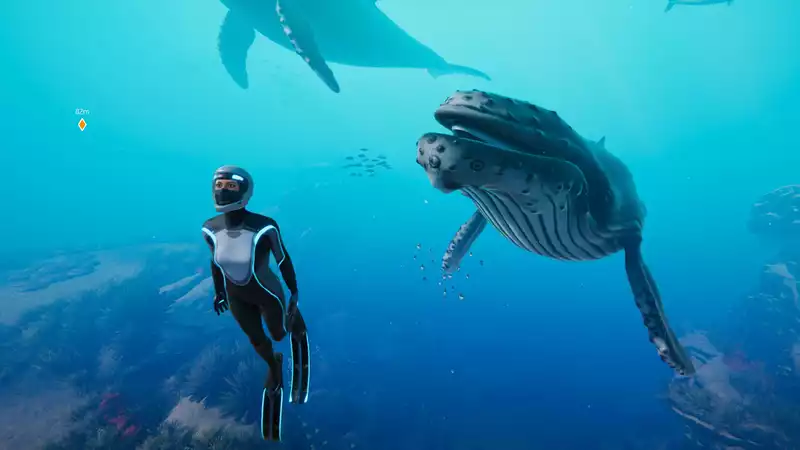I always feel more comfortable when there are field experts on the game's development team. Beyond Blue's comprehensive development process involves scientists and marine biologists, working in close partnership with the crew of BBC's Blue Planet II. A game that aims to both entertain and educate requires a balance between pure learning and engaging storytelling, and while Beyond Blue succeeds in the former, it struggles with the latter.
"Beyond Blue" is a third-person dive simulator that plunges into the calm blue waters of the Western Pacific. You enter the swaying ankles and fins of marine biologist Mirai, who documents a variety of underwater life while tracking a pod of whales. With a small team of scientists, Mirai studies a family of whales, recording their songs and observing their behavior to further her research on these sea giants.
"Beyond Blue" is divided into eight dives, which serve as underwater chapters of the overall story. Each dive begins with a swim to an electronic buoy that pinpoints and scans underwater life. Futuristic technology allows Mirai to dive effortlessly underwater, and the glide is smooth and satisfying, even with the most awkward keyboard and mouse.
Each dive is in a different atmospheric pocket of the ocean. There are waypoints to advance the story, but you are free to explore the impressively realistic environment. Once a pinpoint creature is found, a small drone can be used to get a close-up and examine and record its markings. The game is relatively peaceful, with no imminent danger, although you may come face to face with a giant sperm whale, a hammerhead shark, or an alien-looking squid.
Because Mirai and her team live stream the dives online, there is an ongoing conversation about what a particular fish is and why the team makes certain decisions. While it feels a bit performative due to the live streaming, I really liked the ongoing explanation of what I was doing and why I was doing it.
Once the dive is over, they return to the small submarine that serves as their home base. The scanned organisms are entered into a database and brief information about each species is displayed. In the submarine, you can also chat with Mirai's colleagues or make phone calls to family members. The game follows the same cycle: return to the submarine, talk about the discovery, dive, return to the submarine, talk about the discovery, dive. It is quite repetitive, but the scanning information and mini-documentaries on the submarine's tablet help somewhat to break the rhythm.
The environments vary wildly in terms of how well they represent the wonders of the sea. On one level, you are plunged without a map into a system of connected deep-sea trenches, exploring harrowing and rocky passages. But on another level, there was nothing to see but the blue haze of the open ocean. I understand that the open ocean is an integral layer of the sea, but to dedicate one dive to a space that is practically empty was a bit disappointing, especially with so few chapters.
Unfortunately, many of the dives in Beyond Blue feel a bit uninspired. While the ocean is more realistic than Abzu's magical dream world or Subnautica's alien planet, even the most active environments felt empty. The ocean did not feel like it was teeming with life.
There are some artistic moments, but the environments and storylines are so one-note throughout the three-hour running time that some plot points don't even have time to catch their breath. The devastating effects of deep-sea mining and how certain pollutants are making the ocean a toxic environment for wildlife are briefly touched on, but are over quickly. There is also a storyline about Mirai's grandmother having Alzheimer's disease, but it doesn't progress at all. The game's commitment to realism and its creature database give a sense of the game's good intentions, but the lack of storytelling spoils it. The heart of Beyond Blue lies in the game's mini-documentary footage.
As chapters of "Beyond Blue" progress, you begin to unlock videos that provide insightful information about the state of Earth's oceans. These provide an eye-opening perspective on climate change and our attitude toward the planet, as well as expert insight into the places and species featured in the game. The biologists and scientists who lend their voices to these clips are passionate about studying and saving our vibrant oceans, and it is a shame that the emotion of the videos does not translate to the game.
E-line Media's previous adventure game, Never Alone, was excellent in its presentation of Alaska Native history, stories, and life lessons through both a similar documentary video and an emotional story. Beyond Blue is the perfect game to address the important issues presented by its video, but it fails to delve deeply into those ideas.
While some of the environmental messages are lost, the act of scanning Beyond Blue's creatures and exploring their realistic environments is a great educational tool. The chapters in Beyond Blue feel more like a collection of sober, interactive lectures than a passionate plea for action, but that's not a bad thing."
.

Comments